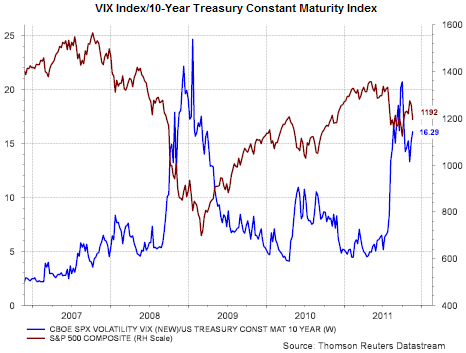
Much of the volatility impacting global markets of late is the result of the European sovereign debt issues. Italy is the latest country to see its bond rates soar.
According to a recent
article in the Wall Street Journal, Italy has €1.9 trillion ($2.6 trillion) in government debt or nearly one-quarter of all euro-zone public debt. Over the course of the next year, Italy must refinance over 15% of its outstanding debt obligations. Given the magnitude of Italy's budget deficit and the recent rise in Italian bond yields, suggests investors are not confident of Italy's ability to deal with these maturities. The size of these debt obligations could be overwhelming for the EU on top of dealing with the debt issues in Greece. This is the type of contagion the EU is trying to prevent.
If history is any guide, past debt defaults by countries have occurred at levels where country debt to revenue levels were much lower. In a November report by
Absolute Return Partners they highlighted the debt to revenue ratios of countries today versus these prior country defaults.
One might ask why Japan is not experiencing a crisis. For one, it has a more diverse economy and more importantly, its interest rates remain at very low levels. However, if Greece and Italy are an example, rates can rise very quickly. As noted in
Absolute Return Partners' November report, "'A country is bust when the markets decide,'" as stated by Albert Edwards, Societe Generale Cross Asset Research.
So how does the U.S. debt structure compare with countries in Europe that are encountering refinancing risk. If one looks at the country debt level, both on and off balance sheet debt, the U.S. is only behind France in terms of liabilities.
Of potential concern for the U.S. is the level of debt maturing over the course of the next five years.
Compared to many other countries, the percentage of short term debt maturing in less than five years is largest for the U.S.
Of particular concern for the U.S. is the level of its budget deficit in spite of the fact
revenues into the treasury continue to grow. The U.S. currently borrows nearly 39 cents for every dollar it spends. Additionally, interest expense is $241 billion or 6% of the government's budget. Given the low level of interest rates on the Treasury's debt, the 10-year Bond is just over 2%, it would not take much of an interest rate spike in the U.S. to negatively impact the government's budget.
Absolute Return Partners highlighted comments from the Fed's summer Jackson Hole Wyoming meeting where the Bank for International Settlements concluded,
"...the debt problems facing advanced economies are even worse than we thought. Given the benefits that governments have promised to their populations, ageing will sharply raise public debt to much higher levels in the next few decades. At the same time, ageing may reduce future growth and may also raise interest rates, further undermining debt sustainability. So, as public debt rises and populations age, growth will fall. As growth falls, debt rises even more, reinforcing the downward impact on an already low growth rate. The only possible conclusion is that advanced countries with high debt must act quickly and decisively to address their looming fiscal problems. The longer they wait, the bigger the negative impact will be on growth, and the harder it will be to adjust."
For the U.S. then, they must address their deficit issues sooner versus later. One significant component will be to create an environment that has a positive influence on economic growth. Additionally, the growth rate in entitlement expenditures must be curtailed. The solutions offered by the ill conceived deficit committee in Washington will certainly be important.

















